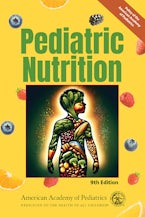Significantly revised and updated by more than 100 contributors, the ninth edition provides the latest evidence-based guidance on the full spectrum of nutrition issues for newborns, infants, children and adolescents.
Constituting the authoritative AAP policy on pediatric nutrition, topics covered include nutritional guidance for all pediatric age groups; micronutrients and macronutrients; nutrient delivery systems; nutrition issues relating to a wide rang of acute and chronic illnesses; and public health issues such as food insecurity, federal regulation, and food safety.
New in the 9th Edition- Sustainability
- Organic Foods
- GMOs
- Revamped guidance on obesity, reflecting the latest AAP policy statement
Topics include:- Nutrient-Gene Intreractions
- Feeding the Infant
- Feeding the Child and Adolescent
- Micronutrients and Macronutrients
- Nutrient Delivery Systems
- Nutrition in Acute and Chronic Illness
- Nutrition and Public Health
Introduction
Part I. Nutrient-Gene Interactions
Chapter 1. Nutrition for the 21st Century: Integrating Nutrigenetics, Nutrigenomics, and Microbiomics
Part II. Feeding the Infant
Chapter 2. Development of Gastrointestinal Function
Chapter 3. Breastfeeding
Chapter 4. Formula Feeding of Term Infants
Chapter 5. Nutritional Needs of the Preterm Infant
Chapter 6. Complementary Feeding
Part III. Feeding the Child and Adolescent
Chapter 7. Feeding the Young Child
Chapter 8. Adolescent Nutrition
Chapter 9. Nutrition in School, Preschool, and Child Care
Chapter 10. The Global Burden of Pediatric Undernutrition and Malnutrition
Chapter 11. Nutritional Aspects of Vegetarian Diets
Chapter 12. Sports Nutrition
Chapter 13. Fast Foods and Fad Diets, Including Herbal Products and Botanicals
Part IV. Micronutrients and Macronutrients
Chapter 14. Protein
Chapter 15. Carbohydrate and Dietary Fiber
Chapter 16. Fats and Fatty Acids
Chapter 17. Calcium, Phosphorus, and Magnesium
Chapter 18. Iron
Chapter 19. Trace Elements
Chapter 20. Vitamins
Part V. Nutrient Delivery Systems
Chapter 21. Parenteral Nutrition in Children and Adolescents
Chapter 22. Enteral Feeding for Nutritional Support in Children and Adolescents
Part VI. Nutrition in Acute and Chronic Illness
Chapter 23. Assessment of Nutritional Status in Children and Adolescents
Chapter 24. Feeding and Swallowing Disorders in Infants and Children
Chapter 25. Malnutrition, Undernutrition, and Failure to Thrive
Chapter 26. Nutrition and Pediatric Diarrheal Disease
Chapter 27. Nutrition in Children With Inborn Errors of Metabolism
Chapter 28. Nutrition Therapy for Children and Adolescents With Type 1 and Type 2 Diabetes
Chapter 29. Nutrition in Children With Dyslipidemia
Chapter 30. Pediatric Obesity
Chapter 31. Food Allergy in Children
Chapter 32. Nutritional Support of Children With Developmental Disabilities
Chapter 33. Nutrition of Children Who Are Critically Ill
Chapter 34. Eating Disorders in Children and Adolescents
Chapter 35. Nutrition for Children With Sickle Cell Disease and Thalassemia
Chapter 36. Nutritional Management of Children With Renal Disease
Chapter 37. Nutritional Management of Children With Cancer
Chapter 38. Nutrition in Management of Chronic Autoimmune Inflammatory Bowel Disease in Children
Chapter 39. Nutrition in Children With Liver Disease
Chapter 40. Cardiac Disease
Chapter 41. Nutrition in Children With Short Bowel Syndrome
Chapter 42. Nutrition in Cystic Fibrosis
Chapter 43. Nutrition and Oral Health in Children
Part VII. Nutrition and Public Health
Chapter 44. Sustainability, Organic Foods, GMOs, and Food Safety
Chapter 45. Preventing Food Insecurity: Available Community Nutrition Programs
Chapter 46. Federal Regulation of Foods and Infant Formulas, Including Addition of New Ingredients: Food Additives and Substances Generally Recognized as Safe
Chapter 47. Federal Regulation of Food Labeling
Chapter 48. Food Safety: Infectious Disease
Chapter 49. Food Safety: Pesticides, Industrial Chemicals, Toxins, Antimicrobials, Preservatives, Irradiation, and Food Contact Substances
Appendixes
Appendix A. Composition of Human Milk
Appendix B. Infant Formula Regulations
Appendix C. Increasing Caloric Density of Infant Formulas
Appendix D. Dietary Recommended Intakes
D-1: Recommended Intakes
D-2: Recommended Tolerable Upper Intakes
Appendix E. Selected Nutrient Content of Foods From USDA National Nutrient Database
Appendix F. MyPlate
Appendix G. Growth Charts
Frank Greer, MD, FAAP is an emeritus professor of pediatrics and nutritional science at the University of Wisconsin-Madison School of Medicine. Board certified in pediatrics and neonatal-perinatal medicine, he earned his medical degree from the University of Pennsylvania, and he completed his residency and fellowship at Children's Hospital Medical Center in Cincinnati.
He was a member (and past chairman) of the American Academy of Pediatrics Committee on Nutrition, and he has served for many years on the Executive Committee of the International Society for Research in Human Milk and Lactation. Doctor Greer has published numerous articles on pediatric nutrition, and he has served as an editorial board member for pediatric and nutrition journals , and is co- editor of the AAP’s Pediatric Nutrition Handbook. He has served on numerous national committees involving nutrition of both term and preterm infants.
Dr. Greer has published many papers nutritional requirements of breastfeeding infants and lactating mothers, including calcium, phosphorus, vitamin D, and iron. Many of these required breast milk analysis in his laboratory.
Steven Abrams, MD, FAAP, is a professor of pediatrics at the University of Texas at Austin and is a practicing neonatologist. He is board certified in pediatrics and neonatal-perinatal medicine. He earned his medical degree from the Ohio State University College of Medicine and completed his pediatric residency at Akron Children’s Hospital and his fellowship at Baylor College of Medicine in Houston.
He was a member (and past chairman) of the American Academy of Pediatrics Committee on Nutrition and is currently the Editor-in-Chief of Advances in Nutrition: An International Review Journal, published by the American Society for Nutrition. He has recently served on several National Academies of Science and Medicine panels related to infant nutrition. He has published over 350 peer-reviewed articles largely related to childhood nutrition, especially mineral requirements and preterm nutrition.

